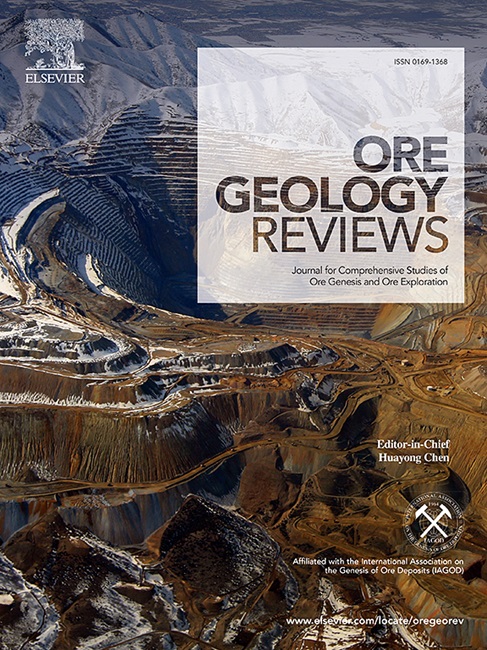The emplacement model of the Qitianling pluton in southern Hunan, China: New insights from 3-D magnetotelluric imaging
IF 3.2
2区 地球科学
Q1 GEOLOGY
引用次数: 0
Abstract
The Qitianling pluton in southern Hunan, China, has spatially and genetically influenced the formation and distribution of a series of polymetallic deposits, including Xintianling, Baoshan, Huangshaping, and Furong. These deposits host a variety of tungsten- and tin-related deposits, often regarded as strategic and critical rare metals, and comprise one of the most prominent reserves globally. A thorough understanding of the structure of the Qitianling pluton is essential for insights into the development and evolution of the metallogenic system in southern Hunan. Working towards the goal of investigating regional structural features and magma emplacements model, we have generated three-dimensional (3-D) electrical resistivity models of the Qitianling pluton and its surrounding areas to upper-crustal depth using magnetotelluric (MT) data that range from 1000 Hz to 0.001 Hz. The results reveal that the upper-crust of southern Hunan is mainly characterized by high resistivity with multiple unique conductive zones. The high-resistivity anomalies (> 1000 Ω·m) are interpreted to represent the Qitianling pluton. In addition, they correspond very well to a negative residual Bouguer gravity anomaly. Moreover, the morphology of the feature aligns with low-velocity obtained by modelling reflected seismic waves. Conductive anomalies (< 30 Ω·m) near the sides of the pluton that extend through the upper crust likely indicate the presence of the Chenzhou-Linwu deep-seated fault system, which may have served as a pathway for the upward migration and emplacement of magma/hydrothermal fluids. Conductive features (< 30 Ω·m) beneath the Qitianling pluton are inferred to represent ancient magma reservoirs where assimilation and mixing processes occurred before magma emplacement. Based on the geophysical models and the available geological data, a multi-stage magma emplacement model of the Qitianling pluton is proposed, which provides new insights into the W-Sn polymetallic mineralization system and the regional magmatic evolution within southern Hunan.

湘南祁天岭岩体侵位模式:三维大地电磁成像新认识
湘南祁天岭岩体对新天岭、宝山、黄坪、芙蓉等多金属矿床的形成和分布具有空间和成因上的影响。这些矿床拥有各种与钨和锡有关的矿床,通常被视为战略和关键的稀有金属,构成了全球最重要的储量之一。深入认识祁天岭岩体的构造,对深入认识湘南成矿系统的发育演化具有重要意义。为研究区域构造特征和岩浆侵位模型,利用1000 ~ 0.001 Hz的大地电磁数据,建立了祁天岭岩体及其周边地区上地壳深度的三维电阻率模型。结果表明,湘南上地壳以高电阻率为主,具有多个独特的导电带。高电阻率异常(>;1000 Ω·m)解释为祁天岭岩体。此外,它们与负残余布格重力异常非常吻合。此外,地物的形态与模拟反射地震波得到的低速相一致。导电异常(<;30 Ω·m),在靠近上地壳延伸的岩体两侧,可能存在郴州-临武深部断裂系统,该断裂系统可能是岩浆/热液流体向上运移和侵位的通道。导电特性(<;30 Ω·m)为岩浆侵位前发生同化混合作用的古岩浆储层。在地球物理模型和现有地质资料的基础上,提出了祁天岭岩体的多期岩浆侵位模型,为湘南地区钨锡多金属成矿体系和区域岩浆演化提供了新的认识。
本文章由计算机程序翻译,如有差异,请以英文原文为准。
求助全文
约1分钟内获得全文
求助全文
来源期刊

Ore Geology Reviews
地学-地质学
CiteScore
6.50
自引率
27.30%
发文量
546
审稿时长
22.9 weeks
期刊介绍:
Ore Geology Reviews aims to familiarize all earth scientists with recent advances in a number of interconnected disciplines related to the study of, and search for, ore deposits. The reviews range from brief to longer contributions, but the journal preferentially publishes manuscripts that fill the niche between the commonly shorter journal articles and the comprehensive book coverages, and thus has a special appeal to many authors and readers.
 求助内容:
求助内容: 应助结果提醒方式:
应助结果提醒方式:


